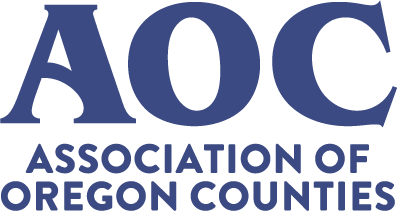
Mar 31, 2025 | AOC Advocacy
Friday, March 21, marked the first major legislative deadline this session, known as the “first chamber posting deadline.” Any bills not posted for a work session in their first policy committee by the deadline will not move forward this session. It is important to note that not all bills that have been posted for a work session will actually move forward through the process. Committee chairs often post bills to keep them “alive” and amendable until the first chamber work session deadline on April 9, after which any bill that has not moved out of its first chamber policy committee cannot move forward this session.
The Association of Oregon Counties’ (AOC) priority bills are almost all moving forward through this deadline, while several bills that AOC opposed will not.
Legislative Affairs Director Mallorie Roberts expressed gratitude to all members and county staff that have responded to AOC’s Action Alerts so far this session. “Public hearing engagement and legislator outreach from individual counties, commissioners, judges, and chairs has a significant impact on AOC’s advocacy efforts,” Roberts said.
Many work sessions will be canceled over the next two weeks. An important caveat – several committees are not subject to the first session deadline – Senate and House Rules, Senate and House Revenue, Ways and Means, and other joint committees, including the Joint Committee on Transportation and the Joint Committee on Addiction and Community Safety Response. Bills in these committees are alive until the second chamber posting and work session deadlines in May.
AOC reviews all introduced legislation and amendments for an impact to county services, budgets, and governance. As always, your AOC Legislative Affairs Department relies on AOC’s adopted principles, member input in our policy process, strategy conversations with steering committee co-chairs, and consultation with county staff subject matter experts to analyze legislation and inform our advocacy.
A comprehensive status update on AOC’s 2025 session priorities and bills on which we have been actively engaged so far this session can be viewed here. A bill list is available on AOC’s Legislative Committee Website and is regularly updated throughout the legislative session.
Contributed by: Mallorie Roberts | Legislative Affairs Director

Mar 31, 2025 | AOC Advocacy, Natural Resources
Senate Bill 777, introduced this legislative session to change the methodology used to determine wolf attack loss grants, easily passed the Senate on Tuesday, March 25, and now heads to the House for consideration.
The bill removes the “missing” category from the types of depredations eligible for compensation and places a multiplier on depredation that occurs based on the type of animal impacted and the recommendation of the county advisory committee. It also increases the amount of grant program funds that must be put toward non-lethal deterrents from 30% to 50%.
Although similar bills have been introduced in prior sessions, the Association of Oregon Counties took the lead this session in working with the Oregon Cattleman’s Association and impacted Oregon counties and provided testimony on the program to articulate why, from an administrative standpoint, the bill was necessary. Although many ranchers in south-central and eastern Oregon participate in the program, there are some counties that see less than 10% of their entire ranching population participate. The changes from SB 777 are expected to encourage more participation in the program, ensuring that more deterrents are on the landscape and that ranchers will be justly compensated.
The Wolf Depredation Compensation and Financial Assistance Grant Program was established as a complementary and necessary program for the full implementation of Oregon’s Wolf Plan, when the Legislature unanimously passed House Bill 3560 in 2011. HB 3560 stipulated grant money would be made available to assist counties in compensating those who suffer loss, injury, or missing livestock due to the presence of wolves in their area. The bill also allocated financial assistance to counties that implement livestock management or nonlethal wolf control techniques. These methods could include, but are not limited to, range riders, spotlighting, pasture monitoring, fox lights, air cannons, non-lethal projectiles, carcass removal and drones with thermal optics, to name a few. HB 3560 also required counties to allocate a minimum of 30% of the funds they request to livestock management or nonlethal deterrents.
To participate in the program, counties were required to establish a county wolf depredation committee. The makeup of a county committee, per ORS 610.150, includes one sitting county commissioner, two livestock owners, two wolf conservationists, and two members of the business community (agreed upon by the other members). In 2012, only eight counties were eligible for funding; however today 18 of Oregon’s 36 counties have established wolf depredation committees.
With the Senate vote of SB 777, this is the first major change to the wolf depredation program in over 10 years.
Contributed by: Branden Pursinger | Legislative Affairs Manager

Mar 26, 2025 | AOC Business Partner
Sponsored content contributed by AOC Business Partner: Oregon Department of Energy
The Oregon Department of Energy (ODOE) has kicked off the second phase of developing the Oregon Energy Strategy, and there are many ways Oregonians can weigh in over the next several months. The agency encourages Oregon counties and their residents to join these important conversations as ODOE works toward a final energy strategy in November 2025.
The Oregon Energy Strategy will identify pathways to achieve the state’s energy objectives. It will evaluate benefits and challenges of different pathways, present policy recommendations for decisionmakers, and reflect input from Oregonians who informed the Strategy.
Using input and comments from Tribes; the energy strategy’s Advisory and Working Groups; staff-to-staff conversations with state agencies, including an Inter-Agency Steering Group; and the public, ODOE and its technical contractors developed scenarios that represent different energy pathways the state could take to achieve its energy policy objectives by 2050.
A Reference Scenario includes “aggressive but achievable” assumptions on the adoption of technologies, such as energy efficiency and electrification, which numerous studies indicate are key to decarbonizing the energy sector. A set of Alternative scenarios each contain a different mix of assumptions about technologies and fuels and that are compared to the Reference Scenario. Building on the results of the energy modeling, additional technical analysis will evaluate effects of different pathways on energy burden for different households in Oregon, air quality and public health, and employment. Geospatial mapping will provide additional context to understand the modeling results.
ODOE and its project contractors presented modeling results for the Reference Scenario and Alternatives earlier this year. The modeling results serve to inform policy discussions in Working Groups and Advisory Group meetings taking place through May – as well as during two public listening sessions on April 24, 2025.
ODOE will also host an information session on April 9 to discuss results of complementary analyses on what the agency is referring to as the energy wallet, air quality, and geospatial mapping considerations. The energy wallet looks at how potential pathways will affect energy spending for five diverse sample Oregon households, in addition to how increased electrification could affect those customers’ energy costs over time. Air quality modeling will look at how changes in air quality coming out of modeled scenarios affect public health and economic benefits. Geospatial mapping will explore community-level energy inequities and relationships with socioeconomic disparities to provide a foundation for deeper insights into policy discussions.
ODOE’s Oregon Energy Strategy team welcomes input and involvement from Oregon counties and those who call them home. Learn more about the project on ODOE’s website.

Mar 26, 2025 | AOC Business Partner
Sponsored content contributed by AOC Business Partner: Covenant Technology Solutions
By now, most of us have heard horror stories of local governments falling victim to cybercriminals — stories of ransomware, phishing attacks, and data breaches. It sounds awful, but for county leaders, this isn’t just background noise. It’s a direct concern. Why? Because you’re responsible for protecting community assets, including sensitive data and critical services.
County leaders in Curry County learned this the hard way. On April 26, 2023, this beautiful southern coastal county was struck by a ransomware attack. Once inside the network, attackers encrypted data, locking the county out of its digital systems. No files. No email. No voicemail. Real estate transactions halted. Police communications failed. Virtually every public service was paralyzed. Employees reverted to paper while IT systems were rebuilt from scratch.
As Curry County Commissioner Brad Alcorn described at the time, “It has impacted every function of this county and literally wiped away our digital footprint.” In an interview with Oregon Public Broadcasting a month after the initial attack (May 2023), Alcorn reported, “We are still not up and running and still struggling through this.” Click here to listen to the entire interview
The attackers demanded a ransom to restore access. However, in line with guidance from the State of Oregon and the FBI, the county did not pay. Instead, it began the costly, painstaking process of rebuilding. Restoring services took months and hundreds of thousands of dollars.
This incident underscores the real-world consequences of cyber threats and the urgent need for local government leaders to prioritize cybersecurity to protect essential community assets. Says Alcorn, “When I woke up on the morning of the 26th, I was focusing on our housing issues. I was focusing on our homeless issues and our funding issues. The last thing on my mind was a cybersecurity attack.” But now Alcorn cautions leaders, “Cybersecurity is expensive. But I have got to tell you, if you’re in charge of any type of government organization, you should really be investing in your cybersecurity infrastructure.”
The takeaway is clear: safeguarding digital infrastructure is no longer optional. It’s a fundamental responsibility. Protecting public trust and essential services starts with building cyber resilience — before disaster strikes.

Mar 25, 2025 | AOC Advocacy
The Joint Committee on Ways and Means kicked off their 2025 community budget hearing meetings on Saturday, March 22, in Gresham. Legislators are travelling around the state to hear from community members about what programs should be prioritized this budget cycle. The Association of Oregon Counties (AOC) encourages members to sign up and testify about your community needs and AOC’s top priority budget items this session. Below are talking points on AOC’s 2025 budget priorities and the committee hearing schedule.
JOINT COMMITTEE ON WAYS AND MEANS ROADSHOW SCHEDULE
Warm Springs
Friday, April 4, 5-7 p.m.
Old Warm Springs Elementary School
Members of the public can register to testify here
La Grande
Friday, April 11, 5-7 p.m.
Eastern Oregon University, Hoke Union Building #339
Members of the public can register to testify here
Salem, Statewide Virtual Testimony Prioritized
Wednesday, April 16, 5-7 p.m.
Oregon State Capitol Building, Hearing Room F
Members of the public can register to testify here
Klamath Falls
Friday, April 25, 5-7 p.m.
Klamath Community College, Building 4 Commons
Members of the public can register to testify here
AOC 2025 BUDGET PRIORITIES TALKING POINTS





